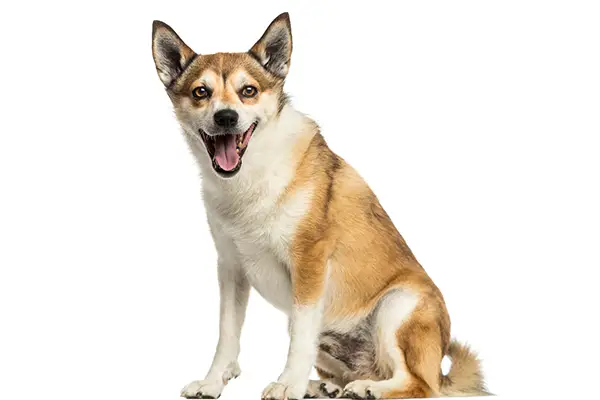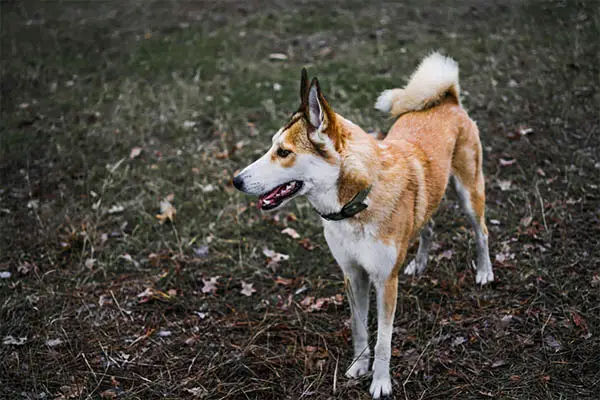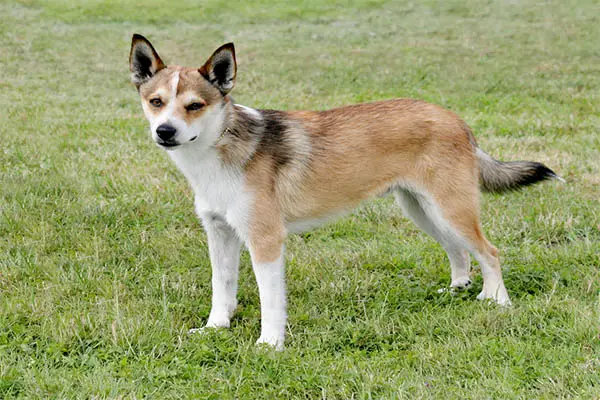The Norwegian Lundehund is a unique dog despite looking normal at first glance. They have a spitz-like appearance with their triangular ears, tails that curve to the back, and their dense double coats. But these dogs are what most people would describe as peculiar. They have six toes, extra paw pads, elastic necks, flexible bodies, and ears that fold.
Norwegian Lundehunds are fun-loving and curious dogs. They need close attention to ensure that they don’t get into trouble. They can also be very challenging to train, so you need patience to have these dogs around. These are definitely not dogs to get if you’re inexperienced.

Norwegian Lundehund Statistics
| Dog Breed Group | Non-Sporting |
| Breed Size | Medium |
| Height | 13-15 inches (male); 12-14 inches (female) |
| Weight | 20-30 pounds |
| Lifespan | 12-15 years |
Norwegian Lundehund Ratings
| Energy level | |
| Exercise needs | |
| Requires attention | |
| Playfulness | |
| Trainability | |
| Shedding | |
| Grooming | |
| Friendly with family | |
| Friendly with kids | |
| Friendly with strangers | |
| Friendly with other dogs | |
| Prey Drive |
Norwegian Lundehund History
Norwegian Lundehunds are rare dogs with ancient history. They were originally developed to hunt puffin birds, a vital food source for farmer residents on the Islands of Lofoten off the coast of Norway.
The dog’s peculiar traits were designed mainly so they can do this job well:
- Their six toes help for easier climbing on slopes.
- Their flexible bodies make it easier to turn around in narrow spaces.
- Their flexible shoulder joints let them spread their legs in a 90-degree angle so they can lay flat on their chest to help them gain more grip on a slippery surface.
- They can fold their ears to prevent debris from going in the ear canal and damaging them.
This is a very well thought out dog and highly-prized dogs by farmers. In fact, farmers would have multiple of these dogs just to receive puffins and their eggs.
However, when net puffin catching became a thing, and the Government placed taxes on those who own this breed, the numbers of Norwegian Lundehunds started to decline. By the early 20th century, the dogs were facing extinction.
Fortunately, an English Setter breeder knew about an island named Værøy that retained a couple of this dog breed in Mostad’s fishing village. She managed to obtain a stock from 6 purebred dogs, and she started a breeding program to save the breed.
By 1987, the first Lundehund was brought to America, but the American Kennel Club didn’t recognize them until 2018. Now, the dogs rank 191st in popularity in the US. Though they’re still rare, it’s safe to say that they’re finally away from extinction.

Norsk Lundehund Temperament
Norwegian Lundehunds are loyal, energetic, and alert dogs. They are wonderful to have in a family as they are fun-loving and happy-go-lucky dogs. They enjoy play sessions and they absolutely love playing with their toys.
Generally, these are very friendly dogs; they get along well with kids, with other pets, and even strangers. They are never aggressive, but they are very observant. They are aware of their surroundings 100% of the time, and they will bark when they see something out of the ordinary.
Remember, these are athletic dogs and they are very clever. They must be kept on a leash outdoors and you must have a secured fence. Keep your eyes on this dog always to ensure that he doesn’t dig his way out and jump or climb over the fence.
Socialization is very important to keep these dogs stable and more well-rounded. It will also help in building up their confidence.
Houstraining, or training in general, can be challenging. You need to be patient and since these are very clever dogs, you need to be smarter than them. Be confident and firm so he obeys you and that he gets the idea that he wouldn’t get what he always wants.

Norwegian Lundehund Care Requirements
- Nutrition: Norwegian Lundehunds don’t need anything but a high-quality and well-balanced meal every day. They have no special dietary requirements but proteins, fats, carbohydrates, vitamins, and minerals. You need to make sure that you only buy high-quality ingredients to ensure that your dog gets the best nutrients. You can get protein from animal meat, fat from fish oils, carbohydrates from whole grains, and vitamins from fruits and vegetables. Adding fruits and vegetables will also do great for your dog’s digestion. Giving your dog commercially manufactured food is also good, but make sure you choose the premium quality products. Check the label to ensure that it doesn’t contain fillers, additives, and by-products. If your dog is allergic to any food ingredient, make sure to stay away from those. Another thing that you should watch is the number of calories you feed your dog every day. This should depend on your dog’s age, activity level, and metabolism. If you’re not sure how much to feed and when to feed your dog, you can always ask your vet for advice.
- Grooming: Norwegian Lundehunds have easy to maintain double coats that shed seasonally. It needs nothing more than weekly brushing to remove dirt and loose hair. However, during the shedding season, you might need to brush them daily to keep shedding to a minimum and make your dog always look his best. Baths can be given once a month or depending on how much your dog needs it. But ears should be cleaned regularly to prevent ear infection. Don’t forget to trim down the nails regularly, too, to prevent your dog from feeling pain and discomfort.
- Exercise: Norwegian Lundehunds are energetic dogs that require regular exercise. Nothing too strenuous is needed. As a matter of fact, a 30-minute walk or play sessions will do. As long as you do lots of activities together, they are the happiest dogs.
- Health: Norwegian Lundehunds are generally healthy dogs, but if there’s one problem to watch out, it’s the gastrointestinal issues. It’s usually brought by genetics and very common to the breed. This is why it was also given the name Lundehund Syndrome. Gastrointestinal issues may vary from one dog to another. These issues include intestinal bowel disease, protein-losing enteropathy, small intestinal bacterial overgrowth, and intestinal lymphangiectasia. With this disease, you need to watch what you feed your dog. The healthier meals, the better. And if possible, always ask your vet’s advice to provide the best nutrition. Take your dog to some screening tests to ensure that there are no other problems. We recommend taking eye evaluation and patella evaluation. Meeting at least one of your dog’s parents will be a very great idea, too.
- Lifespan: The life expectancy of Norwegian Lundehunds is 12-15 years.
Fun Facts About Norsk Lundehunds
- Norwegian Lundehunds originated from the Lofoten Islands.
- The name Lundehund came from Norwegian words “lunde” meaning puffin bird, and “hund” meaning dog.
- These dogs were bred to hunt puffin birds.
- They have six toes that make burrowing easier.
- They can close their ears to protect their ear canal.
- They have flexible bodies, which allow him to turn around, even through a narrow passage.
- They almost went extinct in the early 20th century to the point that only six were left.
- They were recognized by the American Kennel Club in 2008.
Check Out Other Non-Sporting Dog Breeds:
American Eskimo Dog, Bichons Frises, Boston Terrier, Bulldog, Chinese Shar-Pei, Chow Chow, Coton de Tulear, Dalmatian, Finnish Spitz, Keeshonden, Lhasa Apsos, Lowchen, Schipperkes, Shiba Inu, Tibetan Spaniel, Tibetan Terrier, Xoloitzcuintli
